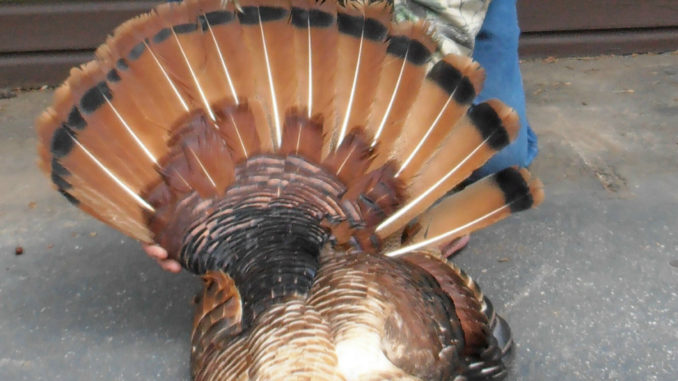
Biologists say bird’s coloration is 1-in-300,000
Odd coloration in Eastern wild turkeys is fairly common across the southeastern states, but Blake Cox of Kernersville bagged a gobbler that may take the 2012 prize in North Carolina.
Cox, 55, and was hunting in Guilford County on April 20 when he shot a gobbler that not only had light cinnamon-brown feathers but also white quills, and its belly and legs were mostly white with mottled brown specks.
The coloration on the bottom half of the turkey, including its legs, looks more like a hawk than a turkey.
“He weighed just slightly less than 20 pounds, had a thick 10-inch paintbrush beard with 1-inch spurs,” Cox said. “But the color — man, I never seen anything like that.”
Cox said two gobblers responded to his calls that morning, but a coyote scared away one of them.
“The turkeys were 30 yards from me, and I was getting ready to shoot, but I didn’t want to shoot while they was (in full strut),” Cox said. “I was waiting for one to stand up, but when one did, both birds weren’t a foot apart. I wasn’t going to take a chance at killing both of them with one shot.”
Cox waited, then a coyote appeared in the field, trying to stalk the turkeys. One of the gobblers saw the predator and ran into a thicket, while the cinnamon bird trotted out of sight after spotting a hen turkey.
“I was fit to be tied,” Cox said. “The brown bird went off into a bottom about 75 yards below me for 1 1/2 hours with the hen.
“Then I heard two more gobblers in the woods. I called, but it was the brown bird that gobbled his head off at me. I kept calling, and two other birds came out of the woods, ran at each other and butted bellies. One took off, running away. The (bigger) cinnamon bird with the hen then showed up and ran after the other bird.”
At that point the two gobblers were in range at 40 yards, so Cox said he whistled, as a hunter might at a walking buck to get it to halt.
“He stopped, and I shot him,” Cox said.
Most of the time when a wild bird has white in its feathers, it’s usually the offspring of a wild bird and a farm-raised, but that wasn’t the case with this wild tom.
Cox took the bird to Oak Ridge taxidermist Martin Kramer.
“Martin said he’d never seen a gobbler colored up like this one,” Cox said. “That’s when I decided to call the National Wild Turkey Federation.”
NWTF officials directed him to Gary Peters, a biologist who works both Carolinas.
“I called Peters and sent him some digital pictures,” Cox said.
Peters said the bird definitely had characteristics of an Eastern wild gobbler, but he hadn’t seen this type of coloration, except to tell Cox “this probably is something (color-wise) you’d see in 1-of-300,000 wild turkeys.”
Peters gave Cox contact information for Bob Eriksen, the NWTF’s chief biologist, who lives n New Jersey.
“This … gobbler looks like a red phase or ‘erythrytic’ eastern,” Eriksen responded in an e-mail. “Bourbon Red domestics usually have white primary and secondary wing feathers and their retrices are also usually white. This bird displays dark primary and secondary wing feathers lacking distinct barring, typically marked upper tail covert and back feathers and body composition typical of easterns. Neat specimen!”
Cox said Peters told him in this gobbler’s past, one of its parents had gotten (genetically) crossed with a “Bourbon” turkey, a domestic turkey.
“But Eriksen told me it didn’t have many characteristics of a Bourbon turkey,” Cox said. “He said a Bourbon turkey has dark markings, and this one’s (markings) are white. He said ‘Your turkey don’t look like a bourbon turkey; it’s more of a cinnamon turkey.’ ”
The hunter said a small percentage of the bird’s feathers are cream-to-light-brown colors, and the tail fan is light cream brown with a black ribbon around the outer edge (typical of an Eastern wild gobbler’s marking). “But the center of each quill is white like it was bleached,” Cox said. “And the legs are marked up like a hawk’s, white with brown patches.”
No matter how it got its coloration, Cox is proud of his unusual bird.
“I tell you, I ain’t never saw nothin’ like it, and I don’t think those NWTF boys had, either,” Cox said.




Be the first to comment